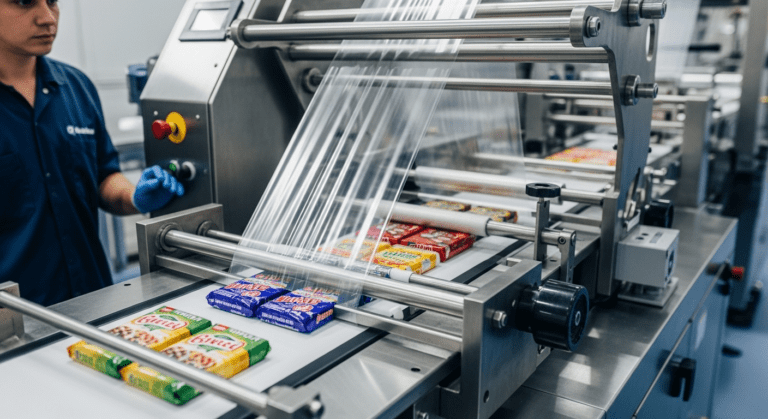Flow wrapping creates a sealed package around products using flexible film material that forms a tight envelope. The process feeds products through a horizontal or vertical machine that wraps film around each item, seals the edges with heat, and produces individually wrapped packages.
This packaging method protects products from contamination, extends shelf life, and provides an attractive retail presentation while operating at high speeds for mass production.
What Is Flow Wrapping
Flow wrapping is a packaging technique that encases individual products in a continuous film wrapper sealed on all sides. The method gets its name from the way products “flow” through the wrapping machine on a conveyor system.
This packaging process works with diverse products ranging from candy bars and baked goods to medical devices and hardware items. The finished package features crimped seals at both ends and a fin seal running along the bottom or back of the product.
Flow wrapping differs from other packaging methods through its speed and versatility. A single machine can wrap hundreds of products per minute while switching between different product sizes with minimal adjustments.
How Does Flow Wrapping Work
Step 1: Product Feeding
Products enter the wrapping machine via an infeed conveyor. Timing mechanisms space items at regular intervals to ensure consistent wrapping.
Step 2: Film Unwinding
A roll of packaging film unwinds from a reel mounted on the machine. The film passes through tension controls that keep it taut and properly aligned.
Step 3: Forming
The film travels through a forming box that shapes it into a tube around the product. Guide rollers position the film edges to overlap slightly along the bottom.
Step 4: Sealing
Heat-sealing jaws create three seals on each package. The longitudinal seal runs along the product’s length where film edges meet. Cross seals form at the front and back of each product.
Step 5: Cutting
A cutting mechanism separates individual packages immediately after the cross seals form. The cutter synchronizes with product movement to ensure clean cuts between packages.
Step 6: Cooling
Sealed packages pass through a cooling section where the heat seals solidify. This prevents seal failure during subsequent handling.
Step 7: Discharge
Completed packages exit the machine on an outfeed conveyor for collection, inspection, or further processing.
Types of Flow Wrapping
Flow wrapping machines come in two main configurations that suit different production needs and facility layouts.
Horizontal Flow Wrapping
Horizontal flow wrappers move products through the machine in a horizontal plane. Products lie flat on a conveyor belt as film wraps around them from above and below.
This configuration works best for solid items that maintain their shape during wrapping. Common applications include chocolate bars, cookies, soap bars, and medical supplies.
Horizontal machines offer easy product loading and high-speed operation. They accommodate various product lengths through simple adjustments and handle multiple products in a single wrapper when needed.
Vertical Flow Wrapping
Vertical flow wrappers drop products through a forming tube while film creates a package around them. Gravity assists product movement through the machine.
This design suits loose or granular products like snack mixes, coffee beans, and frozen vegetables. The vertical orientation minimizes floor space requirements in crowded production facilities.
Vertical machines often integrate with weighing and filling systems above the wrapper. This combination creates complete packaging lines that measure, fill, and wrap products in one continuous operation.
Components of Flow Wrapping
A flow wrapping machine consists of several essential components that work together to create sealed packages:
- Film Reel Stand – Holds the packaging film roll and includes brake systems to control unwinding tension
- Infeed Conveyor – Transports products into the wrapping area at controlled speeds and spacing
- Forming Box – Shapes flat film into a tube configuration around products
- Longitudinal Sealer – Creates the continuous seal along the package bottom or back
- Cross Seal Jaws – Form end seals perpendicular to product movement
- Cutting Knife – Separates individual packages between cross seals
- Discharge Conveyor – Removes finished packages from the machine
- Control System – Manages machine timing, temperature, and speed settings
Types of Materials for Flow Wrapping
Flow wrapping uses various film materials selected based on product requirements, barrier properties, and environmental considerations:
- Polyethylene (PE) – Provides moisture barrier and flexibility for wrapping irregular shapes
- Polypropylene (PP/BOPP) – Offers clarity, stiffness, and excellent printing surface for branded packaging
- Polyethylene Terephthalate (PET) – Delivers superior strength and temperature resistance for demanding applications
- Metallized Film – Creates oxygen and light barriers through thin metal coating on plastic substrate
- Paper-Based Material – Supports sustainability goals while maintaining adequate protection for dry products
- Mono-Material Film – Simplifies recycling by using single polymer types throughout the package structure
- Compostable Film – Breaks down in industrial composting facilities to support zero-waste initiatives
What Is the Difference Between Flow Wrapping and Over Wrapping
The difference between flow wrapping and over wrapping lies in how each method applies packaging material to products. Flow wrapping completely encloses products in sealed film, while over wrapping loosely covers items with folded material.
Flow wrapping creates airtight packages through heat-sealed edges on all sides. The process forms custom-fitted wrappers that conform to product shapes without excess material.
Over wrapping applies pre-cut sheets or continuous film that fold around products like gift wrap. The material overlaps at edges but typically uses adhesive or tucking rather than heat seals.



